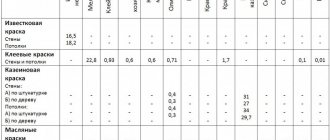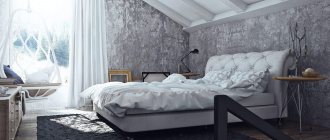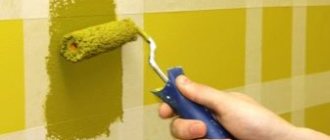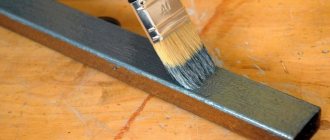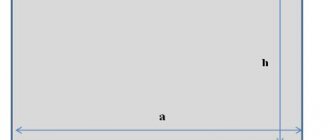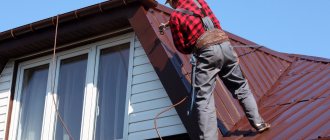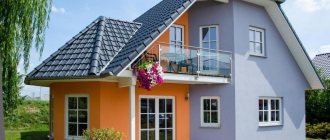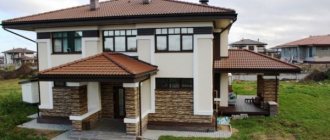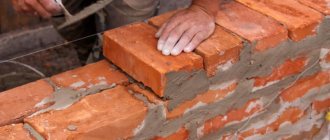Calculating paint per 1 m² can be done with some basic knowledge and motivation. Then you can independently calculate how much material will be needed to paint the facade on plaster, this will help save a decent amount of money.
Painting a plastered facade
It is very important that the coating protects the façade of the building from precipitation, extremely low temperatures, wind and scorching sun, as well as from the harmful effects of air and rainwater. Not only the appearance of a newly built or renovated home depends on the type of paint, its quality and tone. The characteristics of the coating determine the longevity and how the house will look in 10 or even 20 years. Therefore, there is no frugality in buying cheap paint and varnish material; paint consumption is not calculated at all in order to save money. It is better to afford to purchase the best quality paint, in which case the facade will look new for a very long time.
Facades plastered and painted
General information about facade paints
Based on the type of approach to exterior work, facade paints are divided into two groups.
- The first group is organic paints, which are never applied to fresh plaster. This group includes silicone compounds, acrylic paints and silicone-acrylic coatings.
- The second group is inorganic (mineral) paints, which can be used to cover fresh, still wet plaster in about a week. Inorganic formulations are less popular than organic ones. These are silicate paints, lime and cement coatings.
Types of facade paints
When choosing the type of paint for a facade, two main factors must be taken into account: the color range and the degree of air pollution. This will allow you to find exactly the product that is ideal for a particular building and will give it an attractive appearance.
| Type of facade paints | Pollution resistance | Color range |
| cement | low | narrow |
| limestone | low | narrow |
| acrylic | high | wide |
| silicone | high | wide |
| polysilicate and silicate | high | narrow |
The choice of paint is often determined by the type of plaster. When restoring buildings, the most commonly used paints are lime, cement or cement-lime paints. In modern construction, as a rule, thin-layer plasters, silicone, acrylic-based compounds and silicate minerals are used, which are components of a well-thought-out insulation system for a house built using modern technologies. The easiest way to apply a simple principle when buying paint is that it should be the same type as the plaster.
| Type of plaster | Paint type |
| Mineral / cement, brick, concrete | Silicate, silicate-silicone, acrylic, silicone, lime, cement |
| Silicate | Silicate, silicate-silicone |
| Acrylic | Acrylic, silicone |
| Silicone | Silicone |
Different bases for different paints
Why calculate the consumption of paints and varnishes?
Exterior paint is more often perceived as an element of the exterior decor of a home, and therefore many people first evaluate the color of painting materials. However, the decorative component is only part of the role that finishing plays. The following technical characteristics cannot be ignored:
- Moisture resistance . A high-quality paint layer protects the wall material from precipitation and atmospheric moisture and prevents the wall pie from becoming damp.
- Vapor permeability . The ability of the paint layer to allow excess moisture to pass through from inside the wall structure.
- Long service life . A dye that does not fade under the influence of ultraviolet radiation, does not peel off, does not crack, and remains resistant to random mechanical loads is beneficial because it significantly delays the time for the next repair.
- Environmental friendliness . For facade material, it is important not to emit harmful fumes under direct sunlight.
High-quality painting of the facade solves several problems Source fasad-master.com.ua
An important point is to purchase a sufficient amount of paint, for which you need to know at least two quantities: the area to be painted and the consumption of facade paint per 1 m² of wall. Although it is not worth saving on the quality of the composition, it is advisable to determine its quantity as accurately as possible for two reasons:
- Buying paint with a large supply means that you will pay for the excess, which is unprofitable from an economic point of view.
- If there is not enough paint, you will have to buy more. Even if it is on sale, the batch may turn out to be different. The shades of different batches differ even from the same manufacturer, and as a result you will have to put up with a non-uniformly colored facade.
Calculating the amount of paint will help optimize costs Source yandex.net
Painting the walls
Having figured out which paints are best suited and having assessed the scale of the entire action, you can safely proceed to the first stage of repair work.
The variety of colors is limitless
Surface preparation
In any façade work, it is very important to properly prepare the surface, with the exception of ventilated systems.
- If the walls are made of concrete, the most important thing is to clean it from dirt and dust. After which it is necessary to seal all the holes and cracks and allow to dry.
- The same thing applies to the plastered surface of facades; the main thing is to keep it clean and dry - then the paint will adhere better.
- When working on a surface that has already been painted, you should remove all the old façade finishing by cleaning and sanding: the paint does not stick well to itself.
- When painting metal elements, be sure to remove traces of rust, even barely noticeable ones.
- After everything is cleaned and puttied, the surface is primed.
Note! Corrosion, fungi, rust and mold significantly increase the consumption of acrylic facade paint, since in contaminated areas it will more often crack and peel, requiring repair.
Finishing work
When starting to directly apply paint to the surface, you should take into account several nuances that may affect the result:
- The ambient temperature should not be below 5 degrees.
- It is not advisable to carry out work after rain, or you will have to wash it and wait until the surface dries.
- You need to purchase a new brush or roller; working with a tool that has already been in contact with paint is contrary to the norm. The photo below shows a conveniently used roller.
Roller on extended handle
Expert advice:
- The layers must be applied perpendicular to each other: if the first layer of paint was applied horizontally, then the second should be vertical.
- You should wait until the first layer dries, otherwise the paint may wrinkle.
- Try to avoid windy days, which raise dust into the air, which, in turn, settles on the facing material.
Painting instructions:
- Start work from the top of the facade so that the fresh paint does not run off onto the already drying layer.
- After dipping the roller into the container with paint, slowly begin to move it across the surface, lightly pressing on the base.
Special container for paint
- It is better to use a wide brush to cover a larger area at a time.
- After applying the paint, evaluate the result; if it is visible in some places, you will have to apply a third layer.
Use several types of brushes: for joints, corners and other facade elements
Important! In this situation, the material consumption will increase: you will either have to buy more or leave it as it is.
What determines paint consumption?
An owner who wants to determine how many paints and varnishes he needs to buy should start from the consumption of façade paint per square meter of area. The difficulty lies in the fact that there is no single algorithm that allows you to immediately find out the required amount of coloring composition. Consumption is different for each specific facade, and it will depend on the following factors:
- Surface material (its structure and porosity are important) . The relief coating has a larger area than the smooth one, which is reflected in the consumption, which increases by an average of 15-20%. If the base is porous, part of the composition will be spent on filling the pores, and the consumption will increase by 8-10%. At the same time, structural and porous material can increase consumption by 25-30%.
- Selecting a tool . The most economical (as thin as possible) paint is used using a spray gun. Average consumption is provided by the use of a paint roller; For facade work, a tool with a telescopic (retractable) handle is suitable. The brush consumes a maximum of dye, but in some works you cannot do without it.
The more complex the surface structure, the greater the consumption of paints and varnishes Source fotonastenu.ru
- Complexity of work . The façade may contain various architectural details. Hard-to-reach joints, corners, and color combinations require the use of a brush, which means additional waste of paint and varnish composition.
- How many layers will be applied ? Consumption is increasing for obvious reasons. However, it is important to understand that for each subsequent layer, the consumption of facade paint per 1 m² will decrease. For example, if the first layer requires 300 g per square, then when applying the second layer the same amount will be enough for 2-2.5 squares.
- Level of preliminary surface preparation . The primer reduces the consumption of the coloring composition.
- Type of dye (by composition) . This is the determining factor for calculating the required volume.
It is useful to know that the cost of purchasing a paint material sometimes depends on its color and the color of the base. The more different the shades are in color and saturation, the more layers will need to be applied. That is why, if in a few years you want to refresh the facade with the same shade, then one layer will be enough to achieve the desired effect.
Paint consumption when working with a roller and a brush will be different Source amazonaws.com
See also: Catalog of companies that specialize in finishing materials and related work
Relevance and benefits
The façade is one of the main impressions made even at a cursory glance. This statement is true for both cozy private houses and commercial skyscrapers. Property owners and architects strive to give it, if not uniqueness, then at least aesthetic appeal. Textured plastering successfully copes with this task by imparting structure, which is complemented by absolute freedom of choice of color shades.
The bark beetle looks organic not only in the exterior, but also in the interior space, which is why it is loved by designers for creative interior ideas for corridors, halls, balconies and even bedrooms.
But still, the impetus for widespread distribution was not so much the beauty of the resulting relief, but rather its pronounced practicality, due to the following:
- Easy to use, thanks to which not only professional builders, but also home craftsmen can cope with plastering;
- Lightness, reducing the load on load-bearing structural elements, especially significant for multi-story buildings;
- Environmental safety achieved by the complete exclusion from technology of toxic substances that can cause poisoning when heated;
- Biological resistance that prevents the development of molds and mosses in the porous structure;
- Heat resistance, maintained for 70 or more freezing cycles and in the temperature range from - 55⁰С to + 60⁰С;
- Immunity to ultraviolet radiation, guaranteeing equal safety on the sunny and shady side in any climate zone, even to the subtropics;
- Long operational period, subject to technical conditions - more than 15 years in indoor spaces and more than 8-9 years in the open air;
- Acid and alkali resistance, allowing wet cleaning, including with non-concentrated detergents;
- Resistant to accidental damage, removing dirt with a brush or vacuum cleaner;
Photo from repaireasily.ru
The listed points, combined with maintaining the technological nuances of the process, guarantee durability, as well as resistance to atmospheric and other damaging agents. And the variability of relief formation methods and extraordinary colors create countless combinations for the most demanding customers.
Types of façade paints and varnishes
A wide range of dyes are offered on the construction market, which is explained by the variety of building materials and climatic operating conditions. All facade paint and varnish compositions are divided into two groups according to the type of solvent:
- Water-dispersed (aqueous) . Water, in a special form (dispersion or suspension, solid particles in a liquid medium), contains polymer binders: latex, acrylic, vinyl acetate (PVA). The compositions are valuable because they are odorless, and simple water is enough to dilute the dye, wash the instrument or erase stains.
- On organic solvents . The basis is chemical solvents (for example, white spirit). Such paints allow you to get a brighter, denser shade, but take longer to dry, especially at low temperatures. The advantage is that they can be applied at high air humidity, and the pungent odor on the street practically does not cause any inconvenience.
Several types of dyes are used for facade work Source izi.ua
Based on the binder material, compositions for exterior finishing are divided into the following categories:
- Mineral . High-quality crushed natural minerals serve as coloring pigments. As a rule, mineral dyes are understood as lime dyes, the binder of which is slaked lime. There are compositions based on cement or chalk. The main advantages are low cost, preservation of vapor permeability, and resistance to low temperatures.
- Silicate . They are classified as mineral (contain chalk and talc), but they are often separated into a separate group due to the addition of liquid potassium glass. The composition is two-component, so it is mixed immediately before application. It is non-toxic, dissolves in water, and creates a vapor-permeable coating.
- Acrylic . The acrylic polymer emulsion is easy to use, as it can be applied without any special restrictions and is used in exterior and interior work.
Silicone-modified (latex) weather-resistant paint Source alkiv.ua
- Silicone . They combine the advantages of silicate and acrylic compounds. They are characterized by high elasticity, which makes the coating resistant to various external damage and shrinkage processes in the walls. They form a dense layer that is impervious to dirt and atmospheric moisture. The main disadvantage is the high price tag.
Specifications
- The paint base is acrylic resin with additives.
- Dry residue - 70%.
- Drying time before re-application at a temperature of +20° is 10 hours.
- Operating temperature range - from -50° to +70°.
- Permissible air temperatures during application are from -20° to +30°.
- Consumption (conditional) - 0.2-0.3 kg/sq.m.
- The gloss level of the film is matte.
- Solvent type - organic (R-Universal, xylene, etc.).
- The service life of the coating (declared by the manufacturer) is 7 years.
- GOST
28196-89.
IMPORTANT!
The declared service life of the finished coating is designed for normal use and decreases when used in more severe conditions.
The paint manufacturer is the Moscow company KrasKo.
How to cover a plastered facade
In relation to the plastered facade, coloring compositions can be divided into two groups:
- Organic . Acrylic, silicone, acrylic-silicone paints are applied only to finished, properly dried plaster.
- Inorganic . All types of mineral compositions (lime, cement, cement-lime, silicate) are suitable for application to a fresh plaster layer (after a week). Often used during restoration work.
Paintwork materials should be selected based on the characteristics of the façade material; It is clear that the paint consumption per 1 m² for plaster will also be adjusted.
Not all compositions are suitable for painting wet plaster Source otdelka-expert.ru
Self-calculation algorithm
The owners strive to determine in advance the consumption of facade paint per 1 m² of wall; The calculator is available on almost every website of paint and varnish manufacturers, but the calculation is simple and can be done independently. The following data is used for the calculation:
- Material consumption per 1 square . Information is contained on the packaging, for example, 10 m² per liter, that is, 100 ml is enough to cover one square meter. It should be noted that the consumption declared by the manufacturer will only be the same when using a spray gun.
- Number of layers . If the coating is of high quality, two layers are required. One layer is enough in very rare cases, sometimes three are needed.
- Wall area (in meters) . When calculating, it is important not to forget to measure the wall elements that cannot be painted (windows, doors) and subtract their area from the total surface area.
To get the required volume of paint, multiply all three quantities. For rough and porous surfaces (such as plaster), the result must be increased by 20%.
Sometimes determining the area of a façade can be difficult Source artfasad.com
How to calculate area correctly
Before you buy a composition with acrylic, you need to calculate the area of the surface to be painted. To do this, you need to know only two quantities - length and width. To measure the surface to be painted, use a measuring tape or tape measure (metal or plastic). The area is found like this: the length is multiplied by the width (S=A*B). The calculation is made in square meters, since this is the value indicated on the banks.
See also
How to repaint a kitchen facade with your own hands and select suitable compositions
If you need to paint a wall with openings for windows and doors, then measure the total area and area of each opening. Of course, it is recommended to adjust (reduce) the consumption of acrylic for such a surface. This is done like this: the area of all openings is subtracted from the total area.
The consumption of a composition with acrylic for painting architectural elements (columns, niches, protrusions) is calculated by measuring the length and width of each. Then the total area is calculated, consisting of the sum of the areas of the surfaces being prepared for painting.
Briefly about the main thing
Facade paint is applied to plaster for decorative and protective purposes. Several types of composition are used for work. Mineral dyes can be applied to fresh plaster, organic dyes only to dried plaster.
The facade of the house will require significant amounts of dye, and it is not possible to determine the required amount by eye. There is a simple way to calculate by multiplying the area of the facade, the number of layers and paint consumption per unit area. For a rough paint surface, approximately 20% more will be required; the choice of tool also contributes to its error.
Ratings 0
The final stage
After you have applied the paint with your own hands to the facade of the house, you can breathe a sigh of relief - the hardest part is over, all that remains is to decide how to care for it.
- Most paints are tolerant of chemicals, so if the packaging does not indicate that it cannot be washed with household products, feel free to use it. (See also the article Construction of facades: features.)
- Do not use hard brushes or sponges when in contact with the painted surface - this may damage the facade.
- If there is an obvious defect (crack or chip), it is difficult to match the paint color to color, so protect the walls from physical contact.
After reading this article, you can easily choose the optimal paints, count the number of cans and paint the surface yourself. There is a special video: painting the facade, which will help answer the questions that arise.
